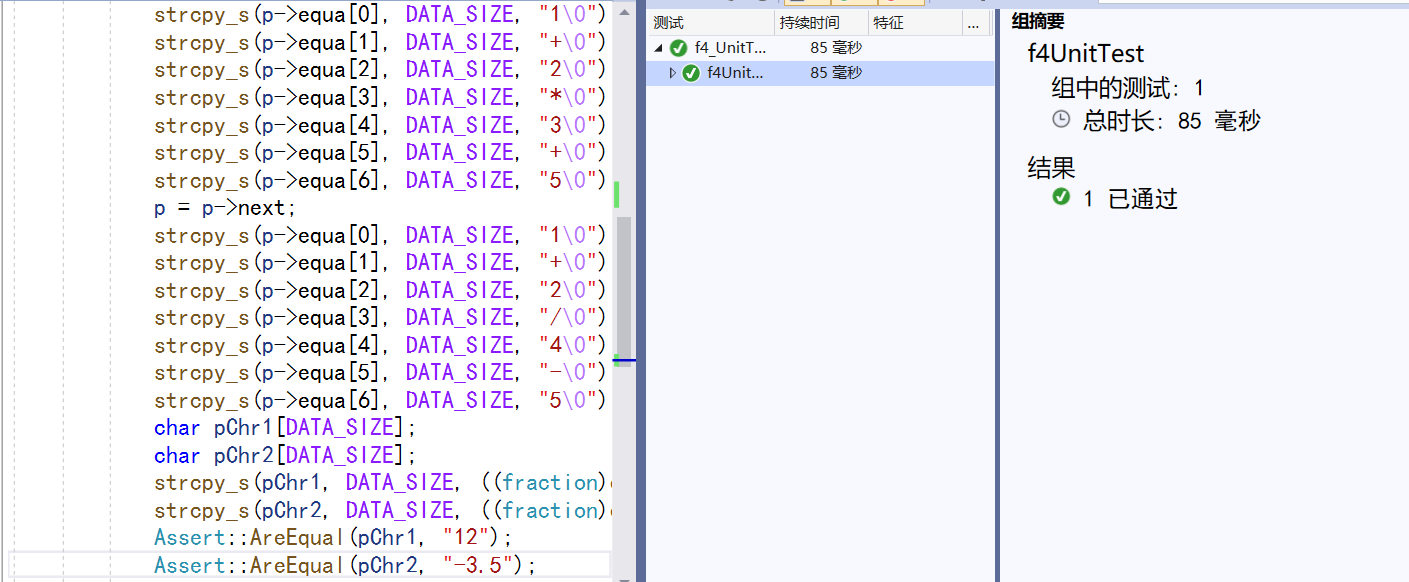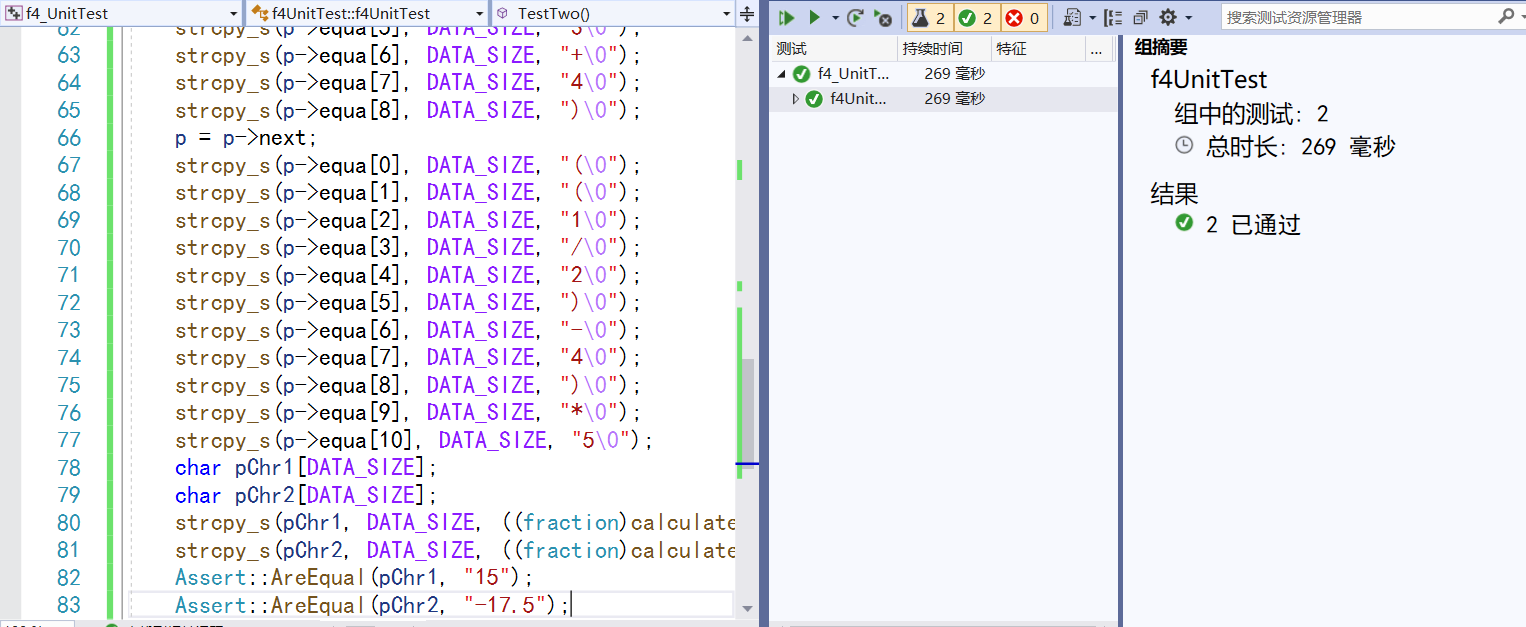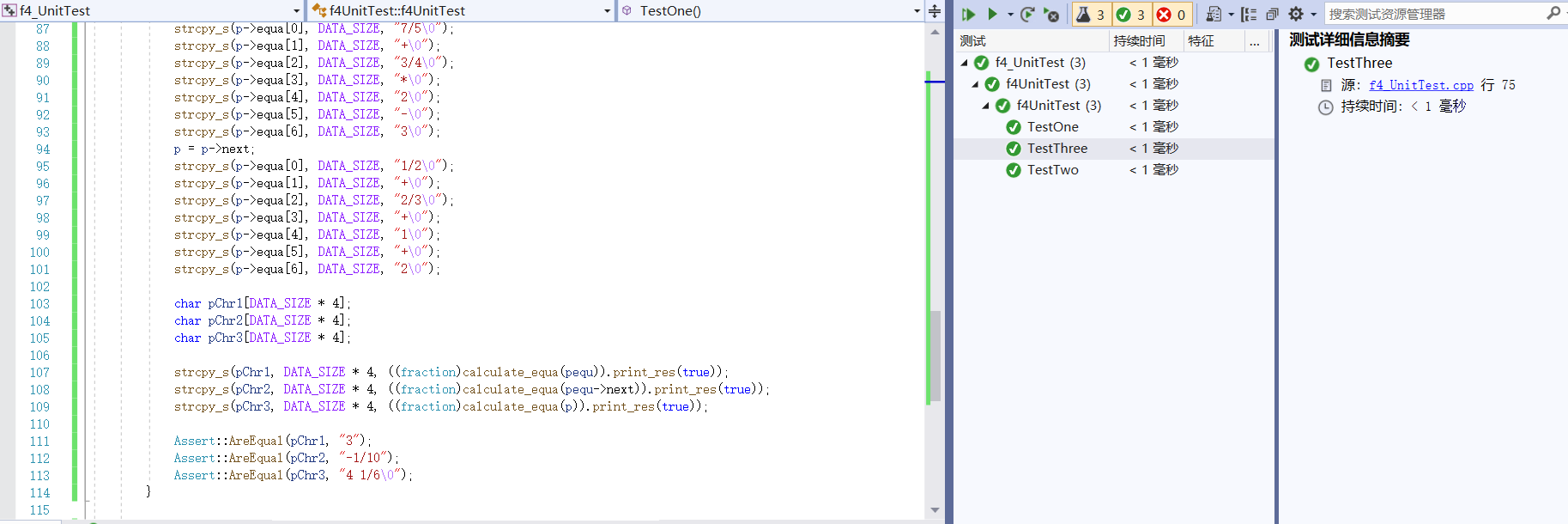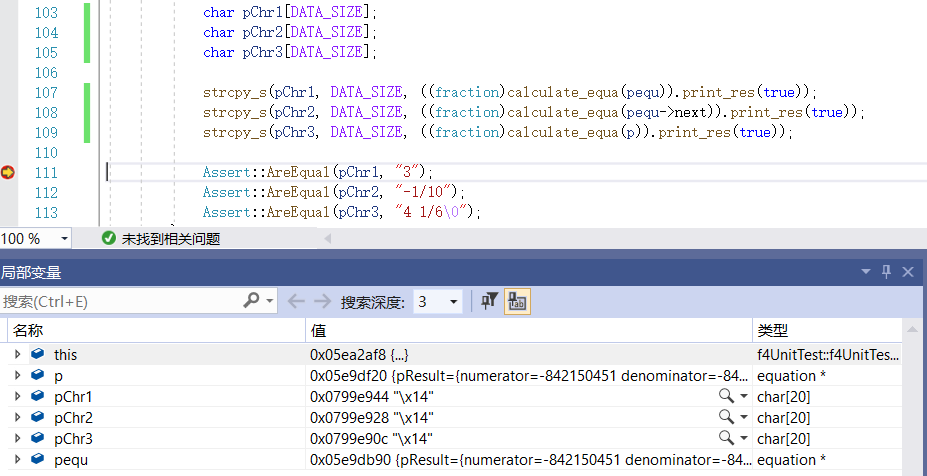此作业要求参见https://edu.cnblogs.com/campus/nenu/2020Fall/homework/11243
测试使用cppUnit框架
结对伙伴是[Nicole]
要求一
1、功能一
测试用例如下
1+2*3+5= 12
1+2/4-5= -3.5
测试编码如下
TEST_METHOD(TestOne)
{
pEqua pequ = create_equa_array(10);
pEqua p = pequ;
strcpy_s(p->equa[0], DATA_SIZE, "1�");
strcpy_s(p->equa[1], DATA_SIZE, "+�");
strcpy_s(p->equa[2], DATA_SIZE, "2�");
strcpy_s(p->equa[3], DATA_SIZE, "*�");
strcpy_s(p->equa[4], DATA_SIZE, "3�");
strcpy_s(p->equa[5], DATA_SIZE, "+�");
strcpy_s(p->equa[6], DATA_SIZE, "5�");
p = p->next;
strcpy_s(p->equa[0], DATA_SIZE, "1�");
strcpy_s(p->equa[1], DATA_SIZE, "+�");
strcpy_s(p->equa[2], DATA_SIZE, "2�");
strcpy_s(p->equa[3], DATA_SIZE, "/�");
strcpy_s(p->equa[4], DATA_SIZE, "4�");
strcpy_s(p->equa[5], DATA_SIZE, "-�");
strcpy_s(p->equa[6], DATA_SIZE, "5�");
char pChr1[DATA_SIZE];
char pChr2[DATA_SIZE];
strcpy_s(pChr1, DATA_SIZE, ((fraction)calculate_equa(pequ)).print_res(false));
strcpy_s(pChr2, DATA_SIZE, ((fraction)calculate_equa(p)).print_res(false));
Assert::AreEqual(pChr1, "12");
Assert::AreEqual(pChr2, "-3.5");
}
测试结果如下图

2、功能二
测试用例如下
1+2*(3+4)= 15
((1/2)-4)*5= -17.5
测试编码如下
TEST_METHOD(TestTwo)
{
pEqua pequ = create_equa_array(10);
pEqua p = pequ;
strcpy_s(p->equa[0], DATA_SIZE, "1�");
strcpy_s(p->equa[1], DATA_SIZE, "+�");
strcpy_s(p->equa[2], DATA_SIZE, "2�");
strcpy_s(p->equa[3], DATA_SIZE, "*�");
strcpy_s(p->equa[4], DATA_SIZE, "(�");
strcpy_s(p->equa[5], DATA_SIZE, "3�");
strcpy_s(p->equa[6], DATA_SIZE, "+�");
strcpy_s(p->equa[7], DATA_SIZE, "4�");
strcpy_s(p->equa[8], DATA_SIZE, ")�");
p = p->next;
strcpy_s(p->equa[0], DATA_SIZE, "(�");
strcpy_s(p->equa[1], DATA_SIZE, "(�");
strcpy_s(p->equa[2], DATA_SIZE, "1�");
strcpy_s(p->equa[3], DATA_SIZE, "/�");
strcpy_s(p->equa[4], DATA_SIZE, "2�");
strcpy_s(p->equa[5], DATA_SIZE, ")�");
strcpy_s(p->equa[6], DATA_SIZE, "-�");
strcpy_s(p->equa[7], DATA_SIZE, "4�");
strcpy_s(p->equa[8], DATA_SIZE, ")�");
strcpy_s(p->equa[9], DATA_SIZE, "*�");
strcpy_s(p->equa[10], DATA_SIZE, "5�");
char pChr1[DATA_SIZE];
char pChr2[DATA_SIZE];
strcpy_s(pChr1, DATA_SIZE, ((fraction)calculate_equa(pequ)).print_res(false));
strcpy_s(pChr2, DATA_SIZE, ((fraction)calculate_equa(p)).print_res(false));
Assert::AreEqual(pChr1, "15");
Assert::AreEqual(pChr2, "-17.5");
}
测试结果如下图

3、功能三和功能四一起测试
测试用例如下
1/3+2/3+1+1= 3
7/5+3/4*2-3= -1/10
1/2+2/3+1+2= 4 1/6
测试编码如下
TEST_METHOD(TestThree)
{
pEqua pequ = create_equa_array(10);
pEqua p = pequ;
strcpy_s(p->equa[0], DATA_SIZE, "1/3�");
strcpy_s(p->equa[1], DATA_SIZE, "+�");
strcpy_s(p->equa[2], DATA_SIZE, "2/3�");
strcpy_s(p->equa[3], DATA_SIZE, "+�");
strcpy_s(p->equa[4], DATA_SIZE, "1�");
strcpy_s(p->equa[5], DATA_SIZE, "+�");
strcpy_s(p->equa[6], DATA_SIZE, "1�");
p = p->next;
strcpy_s(p->equa[0], DATA_SIZE, "7/5�");
strcpy_s(p->equa[1], DATA_SIZE, "+�");
strcpy_s(p->equa[2], DATA_SIZE, "3/4�");
strcpy_s(p->equa[3], DATA_SIZE, "*�");
strcpy_s(p->equa[4], DATA_SIZE, "2�");
strcpy_s(p->equa[5], DATA_SIZE, "-�");
strcpy_s(p->equa[6], DATA_SIZE, "3�");
p = p->next;
strcpy_s(p->equa[0], DATA_SIZE, "1/2�");
strcpy_s(p->equa[1], DATA_SIZE, "+�");
strcpy_s(p->equa[2], DATA_SIZE, "2/3�");
strcpy_s(p->equa[3], DATA_SIZE, "+�");
strcpy_s(p->equa[4], DATA_SIZE, "1�");
strcpy_s(p->equa[5], DATA_SIZE, "+�");
strcpy_s(p->equa[6], DATA_SIZE, "2�");
char pChr1[DATA_SIZE];
char pChr2[DATA_SIZE];
char pChr3[DATA_SIZE];
strcpy_s(pChr1, DATA_SIZE, ((fraction)calculate_equa(pequ)).print_res(true));
strcpy_s(pChr2, DATA_SIZE, ((fraction)calculate_equa(pequ->next)).print_res(true));
strcpy_s(pChr3, DATA_SIZE, ((fraction)calculate_equa(p)).print_res(true));
Assert::AreEqual(pChr1, "3");
Assert::AreEqual(pChr2, "-1/10");
Assert::AreEqual(pChr3, "4 1/6�");
}
测试结果如下图

要求二
功能一的测试中,全部fail。原因在于((fraction)calculate_equa(p)).print_res()这句代码中的print_res()返回的是分数形式,而不是小数形式。修改print_res()函数为print_res(bool bol),当参数为true时输出分数,参数为false是输出小数。当参数为false是的部分代码如下
char pChr[CHAR_SIZE];
if (this->numerator == 0)
{
//printf("0");
sprintf_s(pChr, "0�");
}
else
{
if (this->denominator == 1)
{
//printf("%d", this->numerator);
sprintf_s(pChr, "%d�", this->numerator);
}
else
{
float nume = abs(this->numerator); //获取分子
float deno = abs(this->denominator); //获取分母
float res = nume / deno;
if (this->numerator < 0)
{
//printf("-%d %d/%d", nume / deno, nume % deno, deno);
sprintf_s(pChr, "-%.1f�", res);
}
else
{
//printf("%d %d/%d", nume / deno, nume % deno, deno);
sprintf_s(pChr, "%.1f�", res);
}
}
}
return pChr;
功能二测试全部pass
功能三测试fail,失败原因在于存储运算结果的三个变量pChr1、pChr2、pChr3出现数组越界问题,没有获得真是的结果,调试测试如下图

反复调试发现是在函数((fraction)calculate_equa(p)).print_res(true)中的print_res()函数中出现的数组越界,扩大函数print_res()中存储返回值的数组pChr,由CHAR_SIZE改为CHAR_SIZE*4。代码如下
char pChr[CHAR_SIZE * 4];
if (this->numerator == 0)
{
//printf("0");
sprintf_s(pChr, "0�");
}
else
{
if (this->denominator == 1)
{
//printf("%d", this->numerator);
sprintf_s(pChr, "%d�", this->numerator);
}
else
{
int nume = abs(this->numerator); //获取分子
int deno = abs(this->denominator); //获取分母
if (nume / deno == 0)
{
//printf("%d/%d", this->numerator, this->denominator);
sprintf_s(pChr, "%d/%d�", this->numerator, this->denominator);
}
else
{
if (this->numerator < 0)
{
//printf("-%d %d/%d", nume / deno, nume % deno, deno);
sprintf_s(pChr, "-%d %d/%d�", nume / deno, nume % deno, deno);
}
else
{
//printf("%d %d/%d", nume / deno, nume % deno, deno);
sprintf_s(pChr, "%d %d/%d�", nume / deno, nume % deno, deno);
}
}
}
}
return pChr;
要求三
已做好准备
要求四
单元测试的代码文件名为[f4_UnitTest.cpp],所在的coding地址为https://e.coding.net/nenuwork/ourteam/arithmetic_operation.git